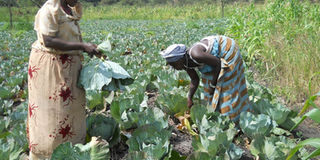How gender balance makes agriculture more profitable

Although women are mostly involved in agricultural production, when it comes to marketing of produce, it is the men who dominate the decision-making. PHOTO BY MICHAEL J SSALI
When we talk about poverty reduction through farming, one may think about helping farmers obtain seed, fertilisers, credit and modern farming technologies.
A lot of effort has been made to promote farming by such measures but there is little socio-economic progress in most farming households and low agricultural production.
Vital questions
This naturally leads to the thinking that perhaps more needs to be done, including examining of attitudes of different members of farming households.
Are they equally involved? Are all of them participants in decision making? Do all feel that the activity belongs to the family?
It is not uncommon to hear people refer to a poultry farm or a coffee plantation as belonging to an individual. Such seems to be our culture—property belongs to the man.
When the milk or the crops are sold, it is the man who decides what to do with the money earned.
More participation
Joseph Nkandu, executive director, National Union of Coffee Agribusinesses and Farm Enterprises (Nucafe), explains:
“We see that coffee has always been referred to as a ‘man’s crop’ but remember that in small-scale family production, it is the women that toil more with the primary activities of weeding, drying and associated post-harvest practices. After that, the men come in to do the marketing and making decisions without the women’s participation.”
This has negative effects; it kills the woman’s entrepreneurial capacity because she does not participate in the entire value chain.
In most cases, when it comes to trainings, the men dominate them but the one who applies what has been taught is the woman.
“One would assume that the man can always communicate to the wife and the family members what he learnt but we all know that there is always distortion in communication,” he adds.
Involve in decisions
In many African countries, farming households derive labour from their families; a man, a woman, and children with an average membership of six, and always outnumbered by females.
This calls for gender equity to ensure enhanced labour productivity. Once the household members are not motivated and do not participate in decision making, productivity levels tend to be low.
Lack of gender equity in farming, according to Nkandu, accounts for 40 per cent of low agricultural production in Uganda.
Transparency is very important in farming households. The husband and wife as well as the grown up children should be equally involved in decision making.
For example the entire family should agree that they need a plastic water tank and that the money earned from the next harvest will be spent on the tank.
They should know how much it costs and they should know how much money has been earned from the harvest.
Since they know how much was earned and how it was spent they are not likely to be suspicious and none should have reason to make unreasonable demands.
Improve status
Transparency and gender equity implies a need for fairness. It increases a sense of ownership and leads to willful participation by all stakeholders.
On the eve of Women’s Day, Kanayo F Nwanze, President, International Fund for Agricultural Development, said: “As men in developing countries migrate to urban centres or shift to better-paid work, a feminisation of agriculture has occurred with approximately half of agricultural workforce worldwide now made up of women.
To improve women’s social and economic status, we need more recognition for the vital role they play in the rural economy.”
Close the gap
On the same occasion, Marcela Villarreal, a director at UN Food and Agriculture Organisation, stressed that food security would improve significantly if women were empowered with the same opportunities that men have.
“Rural women have generally less access than men to productive resources and services. This gap imposes real costs on societies in terms of lost agricultural output, food security, and economic growth,” he said.




